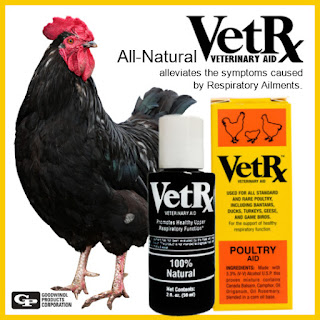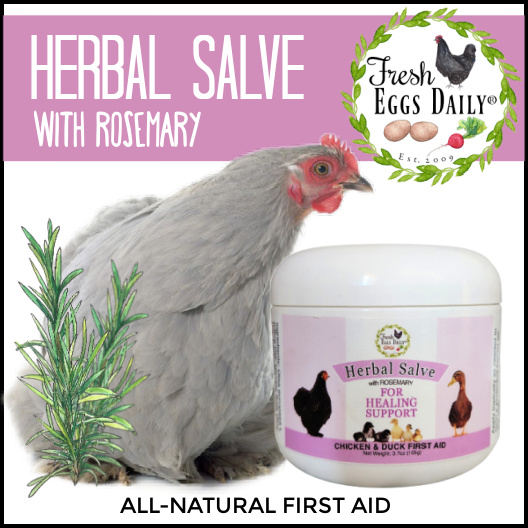Treating Bumblefoot Naturally in Chickens and Ducks
If you raise enough chickens or ducks long enough you will most likely be faced with a case or two of bumblefoot. Funny name, but not such a funny condition for your chickens (or ducks).
What is Bumblefoot?
Bumblefoot is basically a staph infection in which bacteria enters a chicken's (or duck's) foot through a cut caused by a splinter or other sharp object and causes infection which can travel up the leg, causing arthritis, bone infection or septicemia.
If left untreated for long enough, it can potentially kill the chicken or duck.
Fortunately, it's very easy to spot and identify as soon as you know what to look for. Bumblefoot in chickens and ducks presents itself as a small black dot on the underside pad of the foot.
Symptoms of Bumblefoot
Fortunately bumblefoot is very easy to spot and fairly easily treatable. Once you know what to look for, a quick once-over of your girls feet (especially the bottom) every once in awhile will be sufficient to recognize it.
Common symptoms include:
- small black scab on the underside of the foot
- puffy redness between the toes
- swelling and warmness of the foot, especially the pad
- limping
- lack of movement
- loss of appetite
Causes of Bumblefoot
Bumblefoot can be caused by several environmental conditions, including:
- a hard landing off a high roost (tends to affect the heavier breeds)
- excessive chasing or mating activities
- mud or feces in living area
- cut or abrasion on bottom of foot caused by sharp object
- injury to other foot which puts unnecessary weight on foot
- parasites
- poor diet, lack of proper nutrition
Preventing Bumblefoot
You can't really prevent bumblefoot, per se, but you can take precautions to make the chances of your flock succumbing to it lower, including:
- lowering the roosts about 16-18" from the ground as a 'stepping stone' to the higher roosts can help
- lots of soft bedding on the floor of the coop (NOT sand, use either shavings, hemp or straw)
- separating "active" roosters and drakes during mating season for awhile
- providing ducks a kiddie or wading pool during mating season
- keeping the run area well-drained and as dry as possible
- making sure your yard and run is free of sharp stones and rocks, pieces of glass, even pine cones or sharp sticks
- confining any bird with a foot injury to a cage or crate to keep her off her feet as much as possible
- performing regular checks for parasites
- feeding a proper, good-quality diet (Vitamin A specifically has been recommended to prevent/treat bumblefoot)
Treating Bumblefoot
Minor cases of bumblefoot caught early on can usually be treated in 1 or 2 weeks by doing the following:
- Epsom salt soaks
- scraping off the black scab head with a sharp scalpel
- spraying with Microcyn or dabbing with witch hazel
- applying Herbal Salve with Rosemary
- bandaging the foot to keep it clean and dry
- using a piece of rubber or pool noodle as a "donut" to take pressure off the infected part of the foot
- maintaining a clean, dry living environment
- improving nutrition and adding Vitamin A to the diet
Good Sources of Vitamin A
Adding Vitamin A to the diet is fairly easy. Good sources of Vitamin A include:
- broccoli
- leafy green vegetables such as lettuce, kale, and spinach
- squash
- sweet potatoes
- pumpkins
- carrots
- tomatoes
- peppers
- melon
- tuna fish
- eggs
My Personal Experience with Bumblefoot
One morning, I noticed that one of our chickens was limping a bit. Upon a quick inspection, I found that her foot pad was warm and puffy.
Fortunately all my girls, being hand raised from chicks and photographed incessantly, are very used to being picked up and it's not hard to scoop each one up if I need to. Turning her foot over, there was the telltale black scab.
The scab can appear on the pad of the center of the foot or one the toes. Always on the underside and always black. In minor cases caught early on, the scab won't be much larger than a pinhead.
As the bumblefoot progresses, the scab will get larger, and the area around the scab will begin to swell up and get puffy and red.
Treating Bumblefoot Naturally in Chickens
While some might immediately suggest surgery, I recommend surgery only as a last ditch effort. Instead, try treating the infected foot with Manna Pro MicrocynAH Wound & Skin Care Spray.
Spraying the scab several times a day until it goes away can work especially if you catch the infection early enough.
Alternatively, you can dab the scab with witch hazel, which has been studied in the treatment of staph infections.
Or smear the foot with my Herbal Salve with Rosemary.
It can be used to treat bumblefoot as well as minor cuts, scratches, and scrapes, ringworm, hot spots, burns, rashes, rain rot, cinch fungus and more, without stinging or irritating the wound.
Microcyn contains no steroids, antibiotics or alcohols that might hamper the healing process or weaken the animal's immune system. For me, it's a must-have in my chicken first aid kit.
To treat a minor infection, first soak the foot in warm water and Epsom salts for 20-30 minutes to soften the foot pad. Then merely spray the Microcyn on the foot, then wrap it in gauze and secure with vet wrap, repeating three times a day until the infection is gone.
It is well worth the money since a little bit goes a long way.
If, however, after several days the foot doesn't seem to be getting any better, then "surgery" might be your only option.
If Bumblefoot "Surgery" Becomes Necessary
If the foot doesn't improve, or you have a particularly base case, and no vet is available then bumblefoot surgery will likely become necessary.
It is definitely a two-person job. One person to act as 'surgeon' and cut, and the other to hold and provide moral support to both the 'patient' and the 'surgeon'.
It is not a job for the squeamish, but since your chicken's life and comfort could depend on you doing it, it's something that we all should at least know how to do.
Before discovering Microcyn, a friend had a chicken who was suffering from bumblefoot and she asked me to assist. I was the 'holder'.
We have done this surgery three times now, twice on chickens and once on Brigid, our duck, and while I feel confident I COULD do the cutting if absolutely necessary, I am more than happy to just assist.
Preparing to do Bumblefoot Surgery
- A towel
- A small bowl or plastic dish tub of warm water
- Sharp scissors
- Gauze pads
How to do Bumblefoot "Surgery"
First the foot should be soaked in warm water and Epsom salts to soften the skin. Really let it soak for awhile to let the scab soften. Then the scab needs to be pulled off with sharp tweezers, or scraped off with a sharp scalpel and a circle cut around the scab with the scalpel.
Then gently squeeze the foot pad to help remove the hard kernel and all the white stringy stuff - that's the actual infection.
Much as you would think this would be extremely painful to the chicken, from her response, it seemed to merely be uncomfortable. She barely made any sound nor movements during the whole ordeal.
Handling any Bumblefoot Pain
Please resist the urge to put any pain reliever on or administer anything orally to your chicken. There is a better chance of killing the chicken with the pain reliever - any product that ends in 'cane' or 'caine' is toxic to poultry.
Something that I use instead is Bach's Rescue Remedy. It is an all-natural liquid taken orally to calm and relieve stress in animals.
Also, the common yard weed chickweed is a natural pain reliever for chickens and they love it, so if you have some readily available in your yard, give some to your patient to munch on pre-surgery.
Once you have removed the hard kernel and the whitey stringy stuff, generously spray the bottom of the foot with Microcyn.
Fold a gauze pad on top of the open wound and wrap it well with Vet Wrap, separating the toes and add some tape to hold it in place.
You'll want to keep the open wound as clean and dry as possible and I would spray at least twice a day with the Microcyn.
Ducks are also susceptible to bumblefoot, just like chickens. The condition will manifest itself in the same manner with a lump and black scab on the underside of the foot or on the toes.
Ducks with bumblefoot would be treated the exact same way, but with their webbed feet, are a bit harder to wrap and tape.
During one of my routine health checks, I discovered a spot of bumblefoot on one of our Pekin ducks. I finally managed to fashion a bandage that our duck Brigid would keep on and could still manage to walk with.
As you can see, wrapping a duck foot is a bit awkward! If the ground is muddy or wet, separating the 'patient' for a few days so the wound stays clean is a good idea. Otherwise, just keep the foot wrapped well so dirt and mud stays out.
Bumblefoot Recovery
In about a week a new scab should form. As long as the new scab is pink or light tan, not black, you can feel confident that you got the infection out and you can consider your patient cured.
Caught early enough, bumblefoot is quite easy to treat, although it doesn't always cause the chicken to limp, so a quick peek on the underside of each foot is important.
Be sure and keep an eye on your girls' feet so you catch any problems early on and be sure to bookmark this article so you will be able to find it again if you ever need it.
Disclosure: I am not a veterinarian. This is written from my personal experience, hearing around readers experiences, and from reading from various scientific and holistic sources. Your own experience with bumblefoot in your flock could differ based on a variety of factors, including how quickly you catch a case. If you believe the foot is infected, it is always best to consult with a professional as to the best treatment. This post is for informational use only.














.jpg)

































